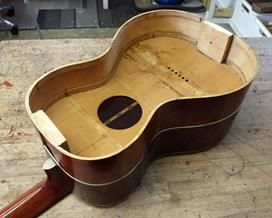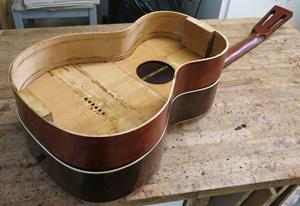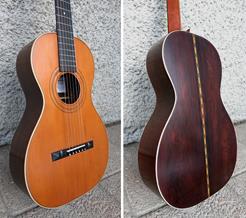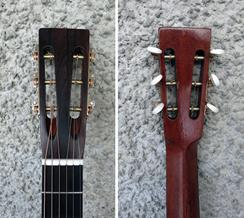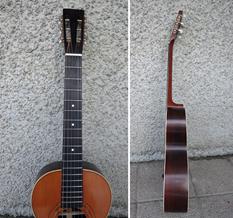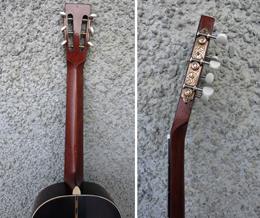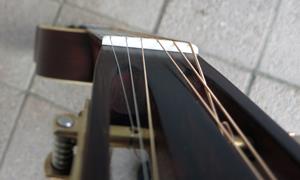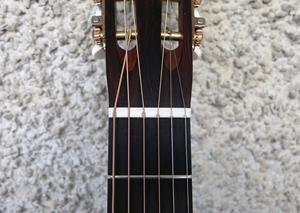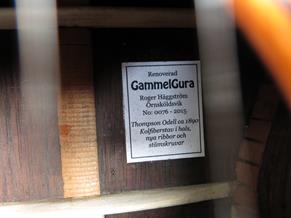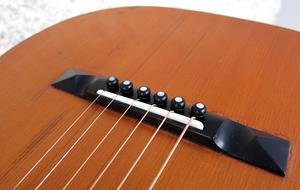An interesting GammelGura based on a parlor from the USA was completed this week. Thompson & Odell made guitars in Boston in the 1890s and a bit into the 1900s. Here is one katalog to look in. The guitar was model 14 - top-of-the-line in the smallest standard size.
What struck me was that it is so similar to Levin's parlor guitars. Almost exactly the same outer dimensions of the body and the same attachment of the neck. I think the good Herrman Carlsson Levin "let himself be inspired" by someone like this 🙂 Took some pictures of a Levin from 1905 on top of the Thompson guitar. Did not move the Levin body when I took the pictures from different angles.
What distinguishes is the choice of wood, Thompson has rosewood in the side and bottom, neck in mahogany and ebony in grip board and stables. It had some extra problems as some wood was found in the lid by the grip board. The tuning screws were not good, a post was also taken. The lid was thin, about 2,5 mm and had cracks. Inserted a reinforcement in the form of a thin fir plate in the middle of the lid with the wire in the same direction as the lid under the stable for it to hold.
Some renovations are not going properly. When the neck was glued, the string height at the stable was one mm higher than I thought. The typical Levin attachment, which is not a real dovetail, means that the foot rests completely on the soft spruce (or mahogany) neck block. When you tighten the strings, the neck can move a tenth and it can be a mm at the stable! With a genuine dovetail attachment, the neck rests against the side, which is much more stable. In normal cases, it works well with a stable leg that is a little too high, but here I kept the original stable which was narrow and there was too little wood in front of the stable leg. When I tightened the strings, the stable leg tilted a little forward - in the long run, the stable would crack from the load. Just bite into the sour apple and turn the neck to bring the stable leg down to a minimal height. Loosened the whole board and had to work hard with the exposed attachment to loosen the fine skin glue that I used the first time.
The guitar was honored with expensive tuning screws by Waverly. It is a pure delight to tune the guitar with these tuning screws, the knobs feel like butter! But then they also cost 🙂
The next problem with the guitar was the pieces of the lid that were taken. No problem to glue new wood and move the decor strip to the rosette from under the grip board. But on the other hand, it was very difficult to match the color of the original lid on the new white bits of spruce. The lid had a golden yellow stain before it was painted. it had also received a later coat of paint, perfectly OK done and thin and fine. Struggled with stains and it turned out OK on hold, but not as good as you want it to be. I willingly admit that I am not very good at varnishes, but it may be that you need to sand the wood and start over from the beginning if such a repair is going to be really good.
I used the guitar as the first candidate for my new method of intoning the oversaddle. It got really good, even though I did not succeed in intoning the stall leg as I like, the narrow original stall did not have room for the angle of the leg that was needed.
Stringed up with Newtone Heritage 0.12 strings. Sounds good I think. Slightly warmer sound from the rosewood compared to a Levin parlor.
Levin parlor 1906 on the left and Thompson on the right. The Levine is slightly rounder in the contour and has a straight head. Otherwise, they are the same as the bear except the wood choice. Thompson has a small radius on the grip board and a narrower stall too. The ribbing of the bottom of Thompson had two wide flat ribs at the bottom as of a Martin, in the lid the ribbing was like a Levin parlor.

